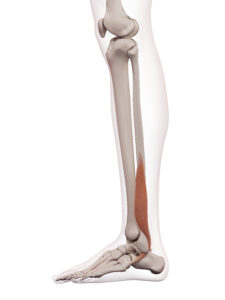The peroneal tendons run on the outside of the ankle and connect the lower leg muscles to the foot. These tendons allow the foot to turn outwards and provide stability to the ankle during weight bearing activities. Inflammation of these tendons causes pain and swelling on the back and outside of the ankle. Please refer to the graphic below for a visual of the ankle tendon anatomy.

Peroneal Tendonitis Causes
- Overuse or rapid increase in training from activities such as running
- Improper footwear
- Recurrent ankle sprains can cause peroneal tendonitis
Peroneal Tendonitis Risk Factors
- Patients with a hindfoot varus posture (heel is slightly turned inwards)
- Patients with high arched feet are more likely to develop peroneal tendonitis
- Patients with tight calves are more likely to develop peroneal tendonitis
Peroneal Tendon Tear Symptoms
- Back and outside ankle pain
- Pain with inversion (turning inward) of the foot
- Feeling of weakness with eversion (turning foot outwards)
Peroneal Tendonitis Treatment
Most cases of peroneal tendinosis heal without surgery. Your orthopedic surgeon may recommend rest, ice, non-steroidal anti-inflammatory medication (NSAIDS), a walker boot, or physical therapy. New shoes or orthotics may be recommended when the patient resumes activities. If the peroneal tendon has torn and requires surgery, it may need to be cleaned out and repaired. In severe cases, the two tendons may need to be connected surgically to heal.
